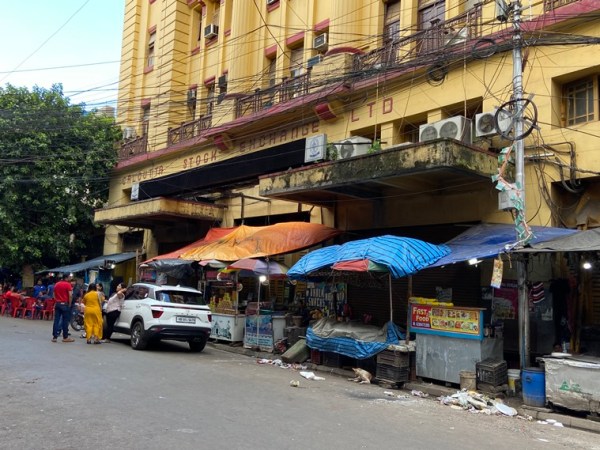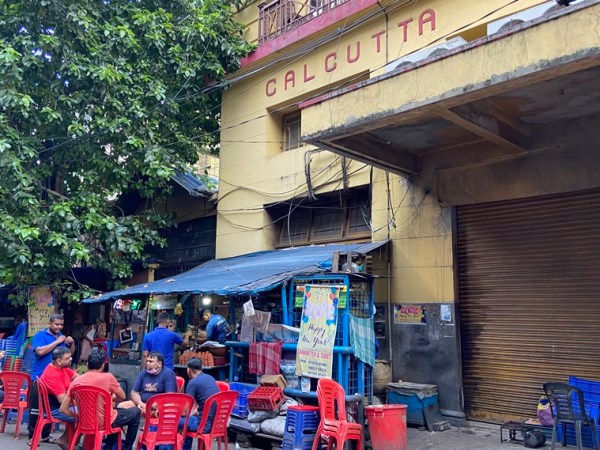A large section of Kolkata’s population, particularly the half that frequents the back lanes of Writers’ Building in the centre of the city for a cup of chai during the weekends, does not know the name of this lane. Instead, Lyons Range is most frequently referred to as the city’s “share market” area or the place where “share market tea” is available.
The street gets its name from the British architect of Writers’ Building, Thomas Lyon, who arrived in the subcontinent as a mere carpenter and worked his way up to become an architect of some of the British East India Company’s most iconic buildings, writes John Fitzhugh Millar in his book ‘The Buildings of Peter Harrison: Cataloguing the Work of the First Global Architect, 1716-1775’.
The street gets its name from the British architect of Writers’ Building, Thomas Lyon (Express)
During pre-Independence India, the area around Writers’ Building was largely occupied by the British and other European officials. In her book ‘Calcutta, Past and Present’ (1905), author Kathleen Blechynden writes that among the British officials who lived in and around Writers’ Building, Robert Clive lived in Lyons Range during the early years of his first administrative tenure in the Indian subcontinent.
Blechynden provides some details of the history of this lane: “The late Mr. Reginald Craufuird Sterndale, while Collector of Calcutta in 1884, found among the records of that office the original pottah of the land which was granted in October, 1776, to Mr. Thomas Lyon, “for the purpose of erecting a range of buildings for the accommodation of the junior servants of the company.” Although the land was granted to Mr. Lyon, whose name has been perpetuated in Lyons’ Range, the street behind the “Range”, Mr. Sterndale was of opinion that he acted in the matter on behalf of Mr. Richard Barwell, the friend and steady supporter in council of Warren Hastings. Whether this was the case, or Barwell purchased the property from Lyon, he was the acknowledged owner in 1780, the year in which the building was completed and was taken by the Government on a five year’s lease, when Francis wrote in his journal, “Mr. Barwell’s house taken for five years by his own vote. Mr. Wheeler and I declare we shall not sign the lease.”
Subscriber Only Stories

Several of the lane’s colonial structures remain standing in Lyons Range, but their purposes have changed, as have the occupants. (Express)
Lyons Range is among the city’s oldest streets and it finds mention in several old maps, the first among which is Wood’s Map of Calcutta, dating back to 1784.
In his book ‘A History of Calcutta’s Streets’, historian P Thankappan Nair writes that the street also finds mention in Bengal and Agra Directory of 1850 where it is also referred to as ‘company kiranee ka bareek ka oothur rasta’.

While their teas and breakfasts of toast, hot buns and the popular ‘malai toast’ which these tea sellers claim to have created, are popular, particularly over the weekend, the shops operate seven days a week, late into the evening, also serving office workers who work in the neighbourhood. (Express)
According to Nair, the first English theatre in the city also existed in Lyons Range and was established in 1745. “Near the Old Court House (where stands St. Andrews’ Church or Scotch Kirk), in the north-west corner of Lyons’ Range, stood the theatre, which, in the siege of 1757, was turned into a battery by the Moors, and annoyed the fort very much. The theatre was generally served by amateur performers and was frequented by the authorities; a ballroom was attached to it,” Nair quotes R C Sterndale’s writings in his book ‘History of Calcutta Collectorate’.
Advertisement
Several of the lane’s colonial structures remain standing in Lyons Range, but their purposes have changed, as have the occupants. The pavements of Lyons Range have been occupied by tea sellers, who over the decades, having acquired popularity among the city’s trading and business community, have not only expanded their businesses and the square feet they occupy, but also the prices of their food.
While their teas and breakfasts of toast, hot buns and the popular ‘malai toast’ which these tea sellers claim to have created, are popular, particularly over the weekend, the shops operate seven days a week, late into the evening, also serving office workers who work in the neighbourhood.
Its proximity to Writers’ Building means that the lane has a heavy deployment of local police vehicles but these buses and cars are interspersed with local fruit vendors who have somehow managed to secure themselves remaining portions of the pavement and road not covered by the street’s other occupants.
Advertisement
On a weekday or even a weekend, one may be hard-pressed to navigate the traffic choking this narrow lane. Whatever little remains of the colonial history of Lyons Range is best found if one ignores the pedestrians and looks up at the buildings and their inscriptions.
Source: https://news.google.com/__i/rss/rd/articles/CBMiggFodHRwczovL2luZGlhbmV4cHJlc3MuY29tL2FydGljbGUvY2l0aWVzL2tvbGthdGEvc3RyZWV0d2lzZS1rb2xrYXRhLWx5b25zLXJhbmdlLXNoYXJlLW1hcmtldC1lYXN0LWluZGlhLWNvbXBhbnktYXJjaGl0ZWN0LTgyODg5MjEv0gEA?oc=5


